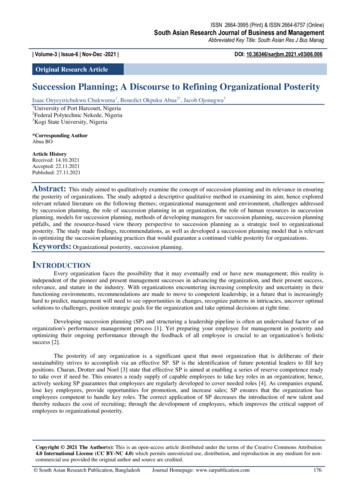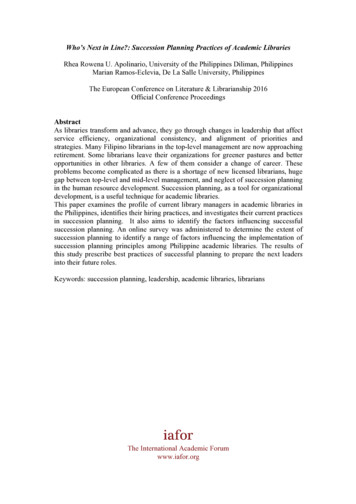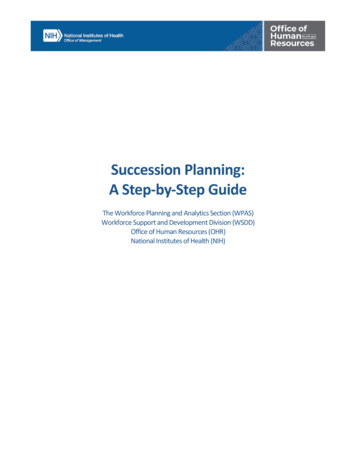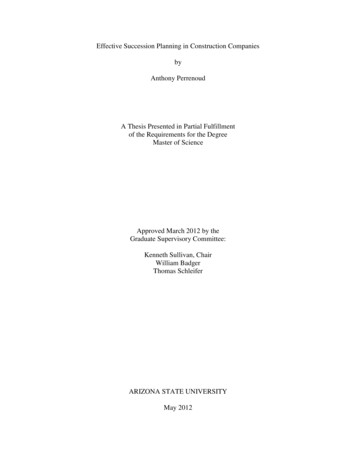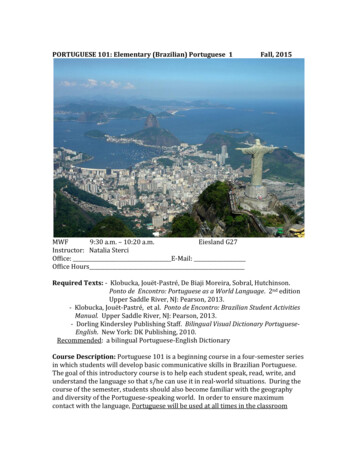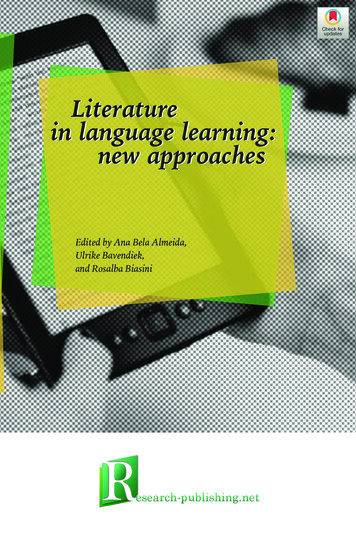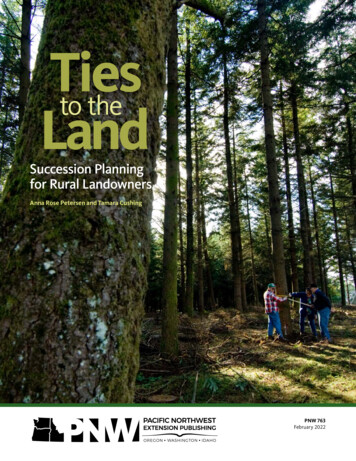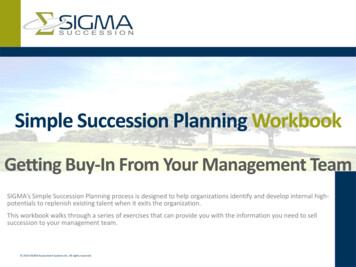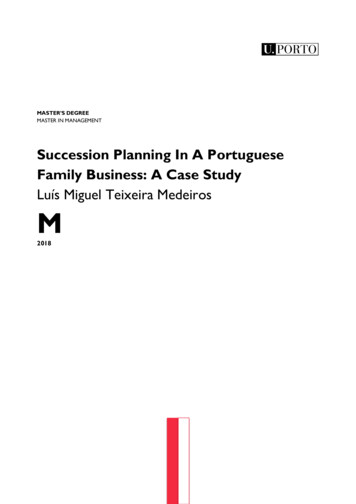
Transcription
MASTER’S DEGREEMASTER IN MANAGEMENTSuccession Planning In A PortugueseFamily Business: A Case StudyLuís Miguel Teixeira MedeirosM2018
FACULDADE DE ECONOMIA
SUCCESSION PLANNING IN A PORTUGUESE FAMILY BUSINESS: ACASE STUDYLuís Miguel Teixeira MedeirosDissertationMaster in ManagementSupervised byDr. Rui Couto Viana2018
ABSTRACTThe succession planning process is one of the main issues that family businesses have to face.The challenge of going through this process is far more complex than passing the ownership ofthe company to one of the heirs. Many companies fail this process, resulting in the “death” ofthe organization. As family businesses have a great importance in Portugal, this research is basedon a case study in a Portuguese family business, Alexandrino Matias e Companhia, S.A. Thisstudy will analyse the succession planning process of this company, that already went throughthe process, by applying previous research findings on this specific case to test theory. The aimis to understand if the previous generation planned the succession, how it was done, and if thecurrent generation is already planning the next one. If they are, what are they doing differently?The data was collected through interviews and historical data of the company.Key-words: family business, succession planning, efficient succession, management, businessadministrationJEL-Codes: D20, D23, L21, L25, L26, M10RESUMOO processo de planeamento da sucessão é um dos principais problemas que os negócios defamília têm que enfrentar. O desafio de passar por este processo é mais complexo do que passara posse da empresa para um dos herdeiros. Muitas empresas falham este processo, resultandona “morte” da organização. Como os negócios de família têm uma grande importância emPortugal, esta pesquisa baseia-se num estudo de caso numa empresa de família portuguesa, aAlexandrino Matias e Companhia, S.A. Este estudo vai analisar o processo de planeamento dasucessão desta empresa, que já efectou a sucessão, aplicando as conclusões de estudos anterioresneste caso específico para testar a teoria. O objetivo é perceber se a geração anterior planeou asucessão, como foi feita, e se a geração atual já está a planear a próxima. Se está, o que vão fazerdiferente. A informação foi recolhida através de entrevistas e dados históricos da empresa.Palavras-chave: negócio de família, planeamento da sucessão, sucessão eficiente, gestão,administração de empresasCódigos JEL: D20, D23, L21, L25, L26, M10II
TABLE OF CONTENTS1. INTRODUCTION . 12. LITERATURE REVIEW . 22.1.DEFINING FAMILY BUSINESS . 22.2.SUCCESSION IN FAMILY BUSINESS . 62.3.THE INFLUENCE OF FAMILY RELATIONSHIPS IN FAMILYBUSINESS . 92.4.THE IMPORTANCE OF COMMUNICATION IN FAMILY BUSINESS . 112.5.SIBLING RIVALRY AND THEIR MOTIVATIONS IN FAMILYBUSINESS . 122.6.THE PROCESS OF SELECTING THE NEXT SUCCESSOR IN FAMILYBUSINESS . 172.7.SIMILAR STUDIES . 242.8.CRITICAL ANALYSIS OF THE LITERATURE REVIEW . 253. RESEARCH METHOD . 263.1.QUALITATIVE RESEARCH . 263.2.QUALITATIVE CASE STUDY METHODOLOGY . 273.3.CASE STUDY DESCRIPTION . 304. CASE STUDY: AMC . 314.1.COMPANY DESCRIPTION . 334.2.FAMILY DESCRIPTION . 354.3.THE STORY OF AMC . 364.4.THE FAMILY BEHIND THE BUSINESS . 37III
4.5.THE SUCCESSION IN AMC . 384.6.THE IMPACT OF THE SUCCESSION ON AMC’S PERFORMANCE . 414.7.THE FUTURE OF AMC . 425. AMC ANALYSIS . 446. CONCLUSIONS AND FUTURE RESEARCH . 507. REFERENCES . 528. ANNEXES. 558.1.ANNEX 1: The structure of the family Matias Magalhães . 558.2.ANNEX 2: Structure of the first interview (Portuguese) . 568.3.ANNEX 3: Structure of the first interview (English) . 588.4.ANNEX 4: Structure of the second interview (Portuguese) . 608.6.ANNEX 6: Structure of the third interview (Portuguese) . 628.7.ANNEX 7: Structure of the third interview (English) . 63IV
TABLE INDEXTable 1: Similar studies of succession in family business .24Table 2: Research methods and data collection on similar studies .28Table 3: AMC’s financial ratios for years 2016 and 2015 .34V
FIGURE INDEXFigure 1: “3-Circle” model of family business . 3Figure 2: Sibling relationships and family firm succession effectiveness . 12Figure 3: A Typology of Incumbents’ Motives for Family Business SuccessionPlanning. 14Figure 4: A Typology of Outcomes Typically Arising from Incumbents’ Motives forFamily Business Succession Planning . 15Figure 5: The differences in the composition of perceived benefits . 16Figure 6: Social capital drivers of succession Bizri . 18Figure 7: Conceptual framework of the direct and indirect influences of the criticalsuccess factors on the succession process .22Figure 8: Family structure of AMC . 31Figure 9: Company structure of AMC .32VI
LIST OF ABBREVIATIONSCEO – Chief Executive OfficerAMC – Alexandrino Matias e Companhia, S.A.VII
1. INTRODUCTIONAs family businesses have a huge importance in Portugal, succession planning is key to assurethe continuity of companies and especially to assure that the results of the organization willremain equal or change for the better. Succession is inevitable, and owners must prepare themvery carefully, because it is not only a matter of ownership, it is about management and how canthey leave the management of the company in good hands when they retire.This research will be based on a case study, using a Portuguese small and medium enterprisecompany as an example of how the succession occurred during the transition of generations.The company is called AMC - Alexandrino Matias e Companhia, S.A., and it is a northernPortuguese company that operates in the mining and quarries industries.The goal is to understand if the predecessors planned or not the succession if the actualsuccessors agreed with the process, if they are planning the next succession and what will theydo differently, to understand if the succession planning process is really affecting theeffectiveness of the succession on companies and its survival.There are a lot of researches that focus on theory building to support the Family Businesstopic, but there is an urge to test all the frameworks and models developed by researches overthe years. As studies have been done mainly using Eastern European and Asian organizations,it is curious to see how a Portuguese company would match the main conclusions of the currentliterature on the succession planning process and transition.The literature review is composed of the main definitions on family business and theproblems raised by the lack of a universal definition, the succession importance, the complexityof the succession process, the importance of communication during the succession process, themotivations for the succession planning, and the selection process of the owners to choose thesuccessors, including not only the heirs but also non-family members as alternatives, and alsothe problem of daughter exclusion on the successor choice.1
2. LITERATURE REVIEWFamily business is as most interesting as it is complex. The family is the oldest social unitin the world and, for family businesses, the family is as important as the business itself (Zachary,2011). Besides, family business is an important subject because it represents an average of over90% of companies over the world, within democratic countries (Daspit, Chrisman, Sharma,Pearson, & Long, 2017; Motwani, Levenburg, Schwarz, & Blankson, 2006). In Europe, morethan 60% of all companies are family businesses (European Commission, 2009), whichrepresents around 690.000 small and medium-sized companies (Molly, Laveren, & Deloof,2010).2.1.DEFINING FAMILY BUSINESSDefining family business is still a big problem today. Even though there are many studiesdone on this subject, there is still a struggle to define this wide and complex concept. There aremany family business definitions. Many authors refer to family business as “a business which isowned and/or managed by a family” (Casrud, 1994; Chua et al., 1999; Intihar & Pollack, 2012)(Cit. By Pounder, 2015, p. 117). According to Pounder (2015), a company can be considered afamily firm if the family control both strategy and top management positions through equityownership. A different perspective is that a family business distinguishes from non-familybusinesses when there is a “family” dimension besides the “business” dimension present incompanies (Motwani et al., 2006). Another interesting definition is that “family business is themanifestation of the associated family system” (Zachary, 2011, p. 27).Donnelley’s early definition of family business (1964) was composed of sevenconditions, where at least one needed to be present for a company to be considered a familybusiness. The conditions were: “existence of family relationships as a key factor in succession; presence of family member on board of directors; reflection of family values in business; actions of family member reflected on reputation of business;2
presence of relatives involved and who felt obligated to hold stock for more thanfinancial reasons; relationship between family members’ positions in the business and theirstanding in the family; entering the firm being part of family members’ career decisions.”(Cit. By Zachary, 2011, p. 28)The study of the European Commission on family businesses (2009) identified morethan 90 definitions, evidencing the presence of a clear variety of opinions on what a familybusiness is. To better understand family businesses, the European Commission (2009) startedby characterizing them, with the help of the “3-Circle” model of family business, created byTagiuri & Davis in 1982. This model is composed of three circles: ownership, family, andbusiness.Figure 1: “3-Circle” model of family business, Tagiuri & Davis, 1982The family circle, many times denominated by “Family System”, is composed by thefamily itself and its capital. According to Zachary (2011, p. 30), “Family’s presence in thebusiness is simply the manifestation of the internal dynamics of the family in and of itself”. Theincomes to family members can be social, human, financial and physical capital, provided byboth families and businesses (Danes et al. 2008) (Cit. By Zachary, 2011). Family capital is “thetotal resources of owning family members and enables the short-term family business success3
and long-term sustainability” (Danes et al. 2009) (Cit. By Zachary, 2011, p. 32), and social capitalrepresents the relations between all family members. Human capital includes “the humanattributes of the individuals in the family” (Zachary, 2011, p. 32).Ownership is what distinguishes family and non-family business. The ownershipdetermines the possession of the business and it is important because it keeps family legacy andtraditions intact (Zachary, 2011). Since most family businesses are small and medium enterprises,ownership and management are assumed to be the same (Nordqvist, Wennberg, Bau’, &Hellerstedt, 2013).A common error on family business is to assume that something can benefit both thefamily and the business, but normally there is a trade-off, putting owners on the position ofhaving to make choices that depend on their priorities, either be the family or the business(Sharma et al., 1997) (Cit. By Bizri, 2016).The complexity of the family businesses brings new challenges. On the one hand, boththe family and the business systems determine the family and business outcomes (Zachary,2011). On the other hand, and according to Zachary (2011), owner managers must find theequilibrium between the importance of the responsibilities in the family and in the familybusiness. A conflict between family, family members, and non-family members cause tension,and both the family and the family business suffer. Families have to be aware of the existence ofthe meeting of both family and business systems (Handler, 1992).The family and business structures will moderate the outcomes produced by the familyand the business (Zachary, 2011).After the study, the European Commission (2009, p. 4) proposed a definition of FamilyBusiness:“A firm, of any size, is a family business, if:1) The majority of decision-making rights is in the possession of the natural person(s)who established the firm, or in the possession of the natural person(s) who has/haveacquired the share capital of the firm, or in the possession of their spouses, parents,child or children’s direct heirs.2) The majority of decision-making rights are indirect or direct.3) At least one representative of the family or kin is formally involved in the governanceof the firm.4
4) Listed companies meet the definition of family enterprise if the person whoestablished or acquired the firm (share capital) or their families or descendantspossess 25 percent of the decision-making rights mandated b their share capital.”(European Commission, 2009, p. 4)This lack of definition brings different problems. This issue of defining family businessmakes this subject particularly complex. For different studies, one can or cannot be a familybusiness. Not having a universal definition, make international studies almost impossible, and itis hard to cross specific data.One other issue is the lack of importance that policy makers give to the specificities offamily business and their contribution to society. The existence of reliable information isessential, not only to policy makers but also to researchers, that assume inaccurate facts (like allfamily businesses are SMEs) because of the lack of robust data (Daspit et al., 2017; EuropeanCommission, 2009). This results in lack of attention from policy makers and the governmentsto family businesses, having no advice nor help in the crucial processes involving family business(Lam, 2011).5
2.2.SUCCESSION IN FAMILY BUSINESSSuccession is defined as the process based on the change of leadership from one familymember to another (Sharma et al., 2001) (Cit. By Bocatto, Gispert, & Rialp, 2010). According toMazzola et al. (2008), succession is a process based on ownership and top managementsuccession.Succession is considered the most important topic regarding family businesses by manyresearchers (Ayres, 1990; Handler, 1994; Le Brenton-Miller, Miller & Steier, 2004; Wang et al.,2004) (Cit. By Bocatto, Gispert, & Rialp, 2010). According to Helin & Jabri (2016, p. 489),“Succession is one of the most difficult strategic issues for a family firm to manage (Chua et al.,2003) as business founders, successors, and executive managers find it difficult to discuss(Hubler, 2009).”. Following interpersonal family dynamics, the succession was the second-mostresearched subject (Dyer, Sánchez, 1998) (Cit. By Lussier & Sonfield, 2012).Succession is required due to the fact that when an entrepreneur creates a company, hisgoal is not to sell the company: the goal is to continue the company through the generations(European Commission, 2009), for the reason that “the human tradition of passing on heritage,possessions, and name from one generation to the next leads both parents and children to seekcontinuity in the family business.” (Barnes & Hershon, 1976, p. 107) (Cit. By Gilding, Gregory,& Cosson, 2015, p. 300). This family legacy continuity intention will influence the process ofmaking decisions of the owners and managers of family businesses (Hammond et al., 2016)(Houshmand, Seidel, & Ma, 2017).This continuity of the business is assured by the replacement of older family membersby younger family members (Konopaski, Jack, & Hamilton, 2015). Also, if the successionplanning is effective, the performance of the company will be positively influenced (Norita etal., 2010) (Cit. By Mokhber et al., 2017), making it important for owners to have a propersuccession process on their businesses.According to Majda (2016), succession planning is both complex and crucial. Whatmakes succession planning so complex is that there are no “best practices” in family business:“what work for one family in one situation will not work for another family in another situation”(Sharma et al., 1997: 17) (Cit. By Motwani, Levenburg, Schwarz, & Blankson, 2006, p. 472), and6
succession planning change its criteria and patterns depending on size and other variables(Motwani et al., 2006). All the minor changes influence the company itself, including theenvironment in which the company is involved in. A study proved that the country is a keyvariable on the degree of succession planning by family businesses, finding that family businessesshow a bigger effort on succession planning in Croatia, Egypt, and Kuwait than in Kosovo,France, and the USA (Lussier & Sonfield, 2012).But the reason why succession is a critical topic is not its complexity, it is due to the factthat succession in most companies represents the end of the company (De Massis et al., 2008)(Cit. By Majda, 2016). Although this seems contradictory, only 30% of the companies caneffectively go through the process of succession from the first to the second generation, and thepercentage goes down to only 10-15% in the third generation (Bocatto et al., 2010). After this,only 3% of the companies survive to the fourth generation and beyond (Mokhber et al., 2017).Therefore, an effective succession can be seen as an accomplishment to the company (Gildinget al., 2015).The major reason for this high mortality in family firms is the lack of succession planning(Ibrahim, Soufani, & Lam, 2001). According to Motwani et al. (2006, p. 475), “East Anglia, UK,Brown & Coverly (1999) concluded that most owners do not plan for their succession”.Succession planning is “the deliberate and formal process that facilitates an effective transfer ofmanagement control from one family member to another (Sharma, Chrisman, & Chua, 1997;Ward, 1987)” (Mazzola et al., 2008, p. 241). Planning is important because succession is acomplex process that occurs during a long period of time in a company, and not just an event(Le Breton-Miller, Miller, & Steier, 2004; Mazzola, Marchisio, & Astrachan, 2008). Mostcompanies fail in the succession process because the founders are afraid of going through thisprocess. According to Lussier & Sonfield (2012), founders often resist giving up the control oftheir companies to the next successors. Often, the owners are unable to “let go” of the business(Gilding et al., 2015; Rosenblatt et al., 1985 cit. by Motwani et al., 2006).According to the European Commission (2009), the main challenge of family firms isthe unawareness of the early succession planning importance, and M. Mokhber et al. (2017)affirmed that succession planning should, in fact, be started at a very early stage in the successor'slife. Gage et al. (2004) also mentioned that “the sooner the company decides to start thetransition process, the greater the probability of success” (Cit. By Majda, 2016). Nonetheless,7
this does not mean that parents should push their children to work inside the company, as mostlikely the children would have a wrong motivation, joining the company simply because they donot want to disappoint their parents (Schröder & Schmitt-Rodermund, 2013). Moreover, youngfamily members may lose interest in being involved in the business (Aldrich & Cliff, 2003)(Houshmand et al., 2017).8
2.3.THE INFLUENCE OF FAMILY RELATIONSHIPS INFAMILY BUSINESSThe loss of interest by young family members can be explained by family relationships.In the last years, the number of researches about the impact of family relationships on familybusinesses has increased (Dyer, 1986; Ward, 1987) (Cit. By Lansberg & Astrachan, 1994). Theimportance of family relationships can be identified by situations that owners must go throughnecessarily, such as choosing a successor when there are several siblings, that can be perceivedas favoritism, which can translate in sibling rivalry and affect the succession process, and thisexample can convert in the general idea that the better the relationships between familymembers, the better the succession process in the family business will be (Lansberg & Astrachan,1994).According to Lansberg and Astrachan (1994), the influence that family relationships haveon succession planning and successor training depends on two variables: the commitment of the family to the company – if the commitment is high,families perceived the organization as a long-term legacy and they prefer businesssuccess over the time than personal profit; the relationship’s quality between the owner-manager and the successor – trust,mutual support, effective communication, sharing of information andknowledge are some of the characteristics of a good relationship.Based on these two variables, Lansberg an Astrachan created a model of familyinfluences on succession, that consists of six proved topics.The first topic is “family cohesion will be positively associated with the quality of therelationship between the owner-manager and successor”, and it is noticed when succession isseen, by the owner-manager and successor, as important to the entire family and not only theinvolved family members. (Lansberg & Astrachan, 1994, p. 44)The second topic is “family adaptability will be positively associated with the quality ofthe relationship between the owner-manager and the successor” (Lansberg & Astrachan, 1994,p. 45).9
The third topic is “family cohesion will be positively associated with the family’scommitment to the firm”, and in cohesive families, there is a big loyalty to the family and to thefamily assets, and parents discuss their hopes about their children’s future (Lansberg &Astrachan, 1994, p. 45).The fourth topic is “family’s commitment to the business will be positively associatedwith the extent of succession planning”, meaning that family members that are committed tothe business perceive its continuity as a clear benefit to the family, and having committed familymembers means that owner-managers are willing to plan a succession because they know thesuccession is possible (Lansberg & Astrachan, 1994, p. 46).The fifth topic is “family’s commitment to the business will be positively associated withthe degree of successor training”, implying successors are willing to learn and be trained(Lansberg & Astrachan, 1994, p. 46).The sixth topic is “the quality of the relationship between the owner-manager and thesuccessor will be positively associated with the extent of successor training”. This means thatboth the owner-manager and the successor have to recognize they have things to learn fromeach other, forgetting the pride and appreciating knowledge (Lansberg & Astrachan, 1994, p.47).According to Lansberg and Astrachan (1994, p. 42), “high cohesion and adaptability areassociated with healthier family relationships and effective communication”.10
2.4.THE IMPORTANCE OF COMMUNICATION IN FAMILYBUSINESSCommunication between all the involved actors is needed so that an effective successioncan be accomplished (Kets de Vries, 1993) (Cit. By Bigliardi & Ivo Dormio, 2009). Lack ofcommunication is a common problem in family businesses (Ibrahim et al., 2001). According toBigliardi & Dormio (2009), all the cases analyzed that represented unsuccessful transitions infamily businesses were characterized by the absence of communication. For that reason,according to Handler (1992), the communications between generations require mechanisms tostrengthen family relations. There is a need to have a good relationship and communicationbetween family members to ensure an effective succession (Bachkaniwala et al., 2001; Helin &Jabri, 2016; Pyromalis & Vozikis, 2009) (Cit. By Mokhber et al., 2017). According to Mazzola etal. (2008), communication and shared knowledge can be increased by planning a successionformally, which can develop internal and external stakeholders network.And the cause for the need of communication is because the process requiresconversations to assure that both generations are aligned on what they want from and for thecompany (Helin & Jabri, 2016), as they need to work together during the transition and beyond(Ibrahim et al., 2001) (Cit. By Mokhber et al., 2017). The goal is to create “long-term involvementamong family members” (Hubler, 2009; Lansberg & Astrachan, 1994; Tatoglu et al., 2008) (Cit.By Helin & Jabri, 2016, p. 488). Communication allows reducing conspiracy (Lansberg, 1988) orresistance (Handler & Kram, 1988) (Cit. By Handler, 1992), which will help to have a positivesuccession experience. As Handler (1992) stated, if there is no conflict among the siblings, thesuccession will be much smoother.If there is conflict among the siblings, there are implications for the family businesssuccession process. Despite the importance of succession planning, many family businesses endtheir operations before the first succession is made, simply because sibling rivalry can degradeboth the family and the business (Avloniti, Iatridou, Kaloupsis, & Vozikis, 2013).11
2.5.SIBLING RIVALRY AND THEIR MOTIVATIONS INFAMILY BUSINESSSibling rivalry is “the competitive relationship between siblings and is often associatedwith the struggle for parental attention, affection, and approval but also for recognition in theworld” (Avloniti et al., 2013, p. 663).To better explain the influence of sibling rivalry on the succession process, Avloniti etal. (2013) developed a framework.Figure 2: Sibling relationships and family firm succession effectiveness, Avloniti et al., 2013The first analyzed impact was the influence of the sibling relationship in the effectivenessof the succession process, because the worse the quality of the relationship, the worse theeffectiveness of the succession process will be.The second impact was the influence of parents’ behavior in the childhood of the heirs,which can influence negatively the sibling relationship since attitudes like unfair treatment, whichparents must avoid, can generate sibling rivalry and lower the possibility of having an effectivesuccession process.The third impact that was analyzed was the influence of sibling characteristics in theirrelationships. The characteristics of the siblings and the family can influence their relationships:the bigger the difference of age, the smaller the chance of conflict between siblings; the biggerthe number of siblings, the bigger the probability of conflict; the higher the number of males12
between the siblings, the bigger the odds of conflict. These variables can influence siblingrelationships and the effectiveness of the succession process.The fourth impact was the perception of fairness in sibling relationships. If siblingsperceive fairness as the distribution according to needs, the better the relationship will be. Onthe other hand, if siblings perceive fairness as the distribution according to rewards, therelationship among siblings will be based on competition, which will worsen the siblings’relationship and the effectiveness of the succession process.To effectively go through the succession process, the key participants must feelcomfortable with each other, without conflict, in order to reach a smooth process (Motwani etal., 2006). And this factor is even more important because “family businesses rely heavily oninterpersonal social relationships” (Hall & Nordqvist, 2008) (Cit. By Konopaski et al., 2015, p.349).But succession is not always smooth since the motives of the key participants for familybusiness suc
literature on the succession planning process and transition. The literature review is composed of the main definitions on family business and the problems raised by the lack of a universal definition, the succession importance, the complexity of the succession process, the importance of communication during the succession process, the
